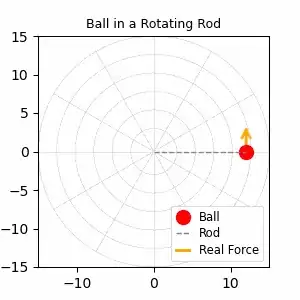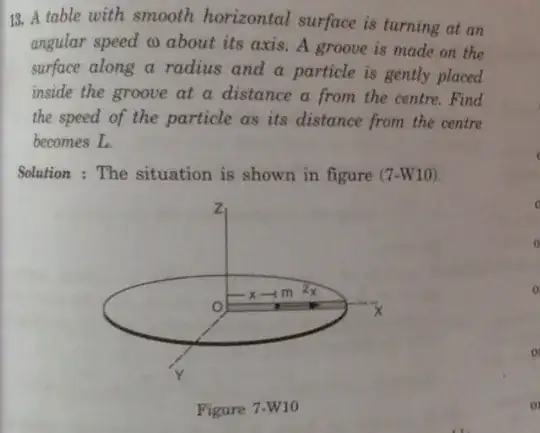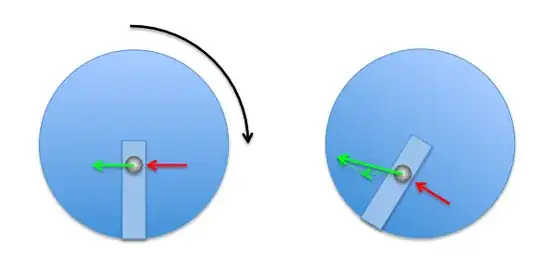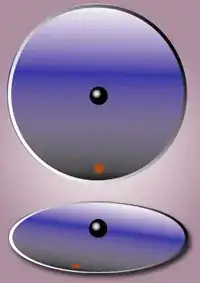We’ve got the familiar ball-in-a-rotating-rod setup. The rod spins at constant speed $\omega \ rad/s$ and the ball of mass
$m$ can slide only along the groove. At $t=0$ you drop the ball at
$(r_0,0)$. In inertial coordinates its path is
$$
\gamma(t)=
\begin{bmatrix}x(t)\\[4pt]y(t)\end{bmatrix}
=
r(t)
\begin{bmatrix}\cos(\omega t)\\[2pt]\sin(\omega t)\end{bmatrix},
\qquad r(0)=r_0.
$$
Cranking out the acceleration
After two rounds of the product rule you get
$$
\frac{d^2x}{dt^2}
=\Bigl(\frac{d^2r}{dt^2}-\omega^2r\Bigr)\cos(\omega t)
-2\omega\,\frac{dr}{dt}\,\sin(\omega t),
$$
$$
\frac{d^2y}{dt^2}
=\Bigl(\frac{d^2r}{dt^2}-\omega^2r\Bigr)\sin(\omega t)
+2\omega\,\frac{dr}{dt}\,\cos(\omega t).
$$
Bundle those into one tidy vector:
$$
\frac{d^2\gamma}{dt^2}
=
\Bigl(\frac{d^2r}{dt^2}-\omega^2r\Bigr)
\begin{bmatrix}\cos(\omega t)\\[2pt]\sin(\omega t)\end{bmatrix}
+
2\omega\,\frac{dr}{dt}
\begin{bmatrix}-\sin(\omega t)\\[2pt]\cos(\omega t)\end{bmatrix}.
$$
Note: the first vector is radial (along the rod), the second is sideways
(perpendicular to the rod). They’re orthogonal—check the dot product.
What forces are really there?
By Newton’s second law, the total force $F$ acting on the ball satisfies
$$F=m \frac{d^2\gamma}{dt^2}.$$
On the other hand, the only real force acting on the ball is the normal push from the groove (or rod). This force restricts the motion of the ball: it allows free movement along the groove, but responds to any motion perpendicular to the groove with a push perpendicular to the groove, carrying the ball along the rotating track. In particular the force is always perpendicular to the groove. That means the total force $F$ has no component in the direction of the groove. So the radial component of Newton’s second law must vanish. That gives
$$
\Bigl(\frac{d^2r}{dt^2}-\omega^2r\Bigr)=0
\quad\Longrightarrow\quad
\frac{d^2r}{dt^2}-\omega^2r=0.
$$
The actual push from the groove is therefore
$$
\mathbf F
=
2m\omega\,\frac{dr}{dt}
\begin{bmatrix}-\sin(\omega t)\\[2pt]\cos(\omega t)\end{bmatrix}.
$$
Solving the radial ODE
The little ODE we just found is
$$
\frac{d^2r}{dt^2}=\omega^2r. \tag{1}
$$
All its solutions look like
$$
r(t)=A\,e^{\omega t}+B\,e^{-\omega t}. \tag{2}
$$
If $\omega>0$ the $A$-term blows up, the $B$-term dies out.
The only way you don’t shoot off to infinity is to fine-tune so $A=0$.
For the gentle release you said $r(0)=r_0$ and
$\dfrac{dr}{dt}(0)=0$. That forces $A=B=r_0/2$, giving
$$
\gamma(t)=\frac{r_0}{2}\bigl(e^{\omega t}+e^{-\omega t}\bigr)
\begin{bmatrix}\cos(\omega t)\\[2pt]\sin(\omega t)\end{bmatrix}.
$$
So unless you nailed that special inward kick ($A=0$), the ball’s distance to the origin $r(t)$
grows exponentially and it flies out along the rod.
I made two animations of the setup in the exercise.
In the first clip the radius blows up so fast that the ball flies off the screen almost immediately—pretty dull once it heads toward $\infty$.
In the second clip I let the camera box rescale on the fly, so the ball always stays in view and you can watch the whole spiral.
Keep in mind the two movies run on different time scales, so “one second” in the first is not the same real-time stretch as “one second” in the second.
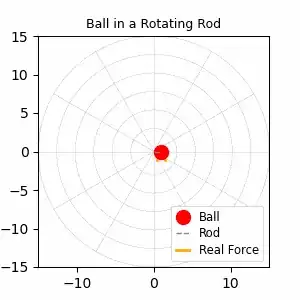
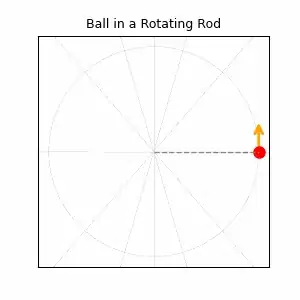
This animation is for the atypical case $A = 0$.
